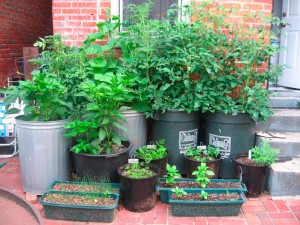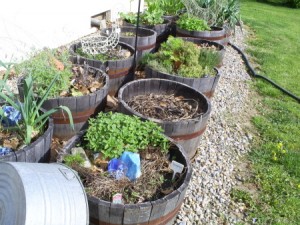Whether you live in an apartment with very little space, or you just want to grow a garden without dedicating tons of time, a container garden is a great option. A good container garden allows you to grow the plants you love, even if your soil or yard is not conducive to growing anything. If you are ready to experience the exciting world of container gardening, these tips will help you grow a successful, unique garden that fits both your space and your personality.
Choose Your Containers
The containers you choose for your container garden are nearly endless, You can go the traditional route and purchase pots and window boxes, or you can use unique containers that add to the beauty of your garden.
Any container that can hold soil, and drain water is an option for your container garden. You can use baskets, which typically drain water quite well, or you can use cans, ornate vases, or even old shoes or teacups to create a visually interesting garden. If the container you choose does not have any holes to allow for drainage, you can carefully add them using drills or other tools.
There are some things you will need to keep in mind when choosing your containers to ensure that they will provide the best growing space for your plants.
- Size – While shoes and other small containers may look interesting, you have to make sure that the plants are not too top heavy for them. Larger plants will require pots that will accommodate their size, and be heavy enough to keep from tipping over.
- Water Requirements – Plants that require plenty of water should be planted in larger containers – otherwise, you will need to water them frequently. Small pots work best with succulents as they do not typically grow too large, and they require less moisture.
- Movement – If you plan on rearranging your plants often to create new looks, you will want to use pots that are not overly large and cumbersome. A great way to show off that large pot that you love is to use it for perennials, or groupings of plants, and make it the focal point of your garden. Use smaller pots that are easier to manoeuvre around it.
Choose Your Plants
The great thing about container gardens is that they allow the freedom to grow a wide variety of plants, even if they would not normally grow in your own soil. The choice in plants often depends entirely on whether you want to take the time to protect those special plants that might need more or less warmth, or more protection from the elements.
You will also need to decide whether you want some of the same plants to grow each year (annuals), or if you would prefer to start all over with new colour schemes the next season. You can also choose to use a combination of flowers, greenery, vegetables, fruits, and small trees to create a unique and useful garden.
If you want to plant a few different types of flowers or plants in the same pot, make sure that each plant has the same soil, sunlight, and watering requirements to ensure that each one grows properly. You will also want to make sure that you do not overcrowd the pots, which will also stunt growth, and leave your plants susceptible to diseases and fungi.
Even if you have grown successful gardens in your own soil, you will not be able to use it for your container garden. Containers naturally compact the soil, and the dirt from your garden will not have the aeration and drainage needed for potted plants.
There are a wide range of potting media available for containers to ensure that the plants will receive proper drainage and air movement around the roots. These potting soils are often made of peat, bark, ground coconut hulls, and many other ingredients that are blended together. These “soils” may not even contain any soil, but still provide a great growing environment. Each potting mixture is often designed for growing specific plants, so make sure to read the labels before buying.
Keep Your Plants Groomed
Container gardens will require grooming in the form of dead-heading, pinching, and clean-up. You will want to use these methods when the plants begin to grow too large for the plants around them, or if you just want to make sure they do not outgrow their container. You will also need to pinch off any leaves or flowers that are dead at least once a week to keep the plants looking their best.
Following these steps will help you build and grow a container garden that reflects your tastes, regardless of how much space you have available.



